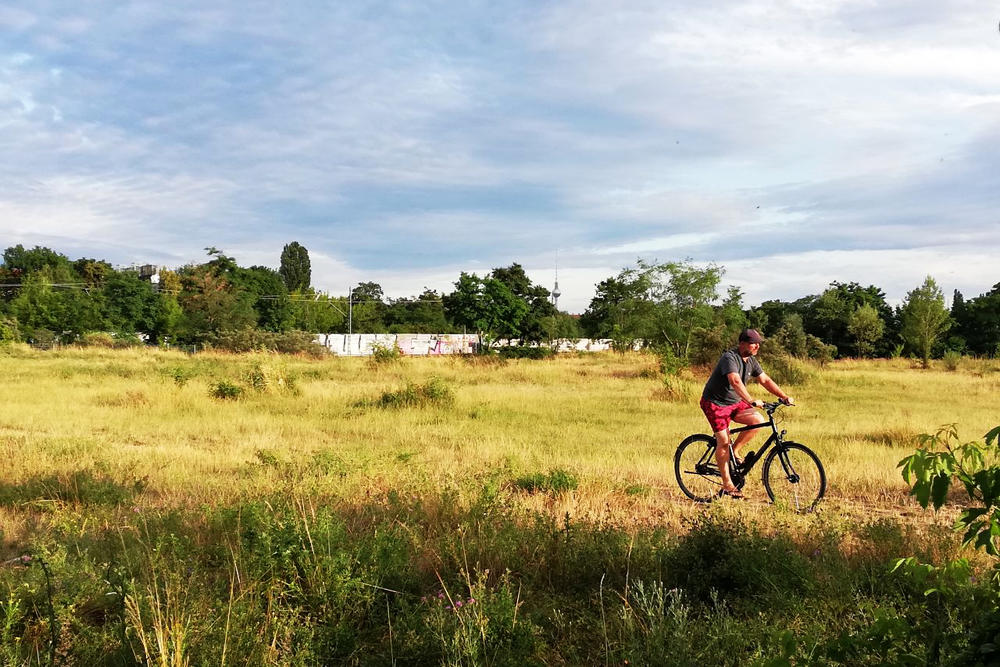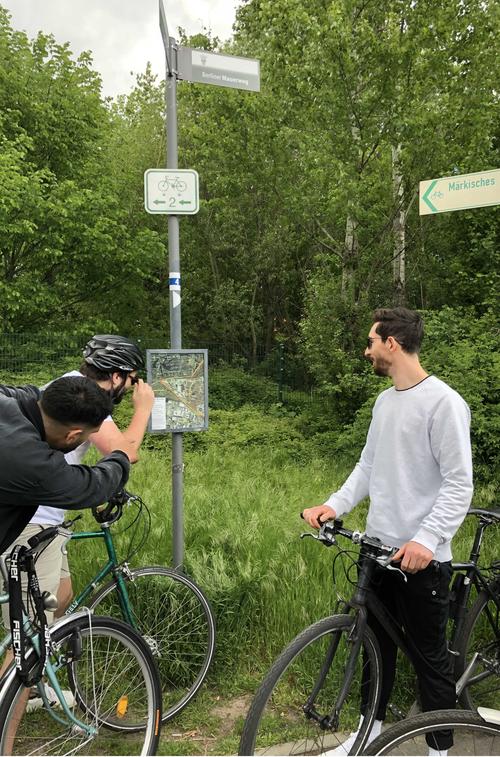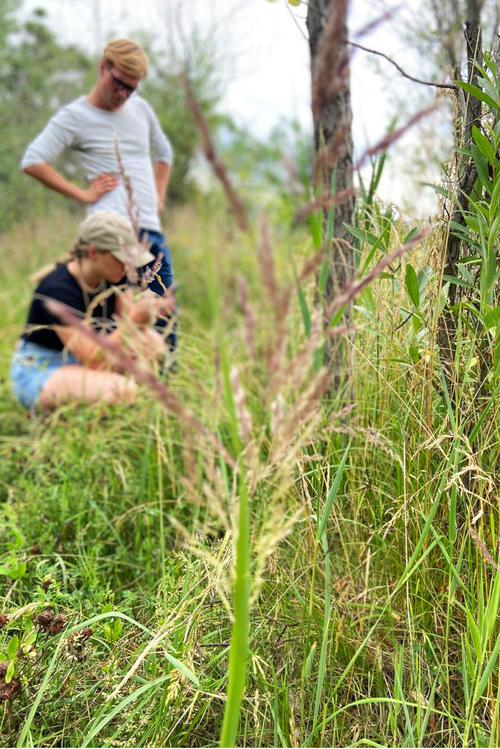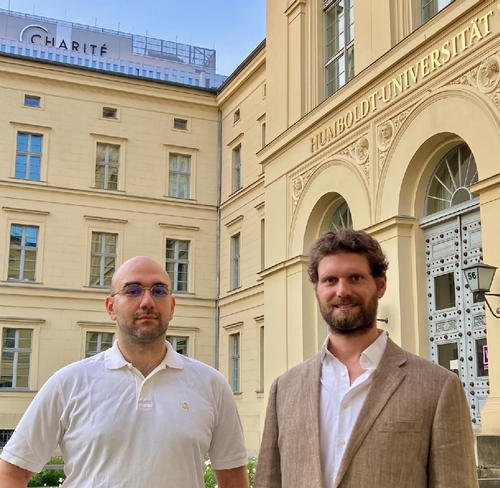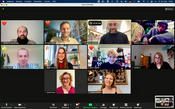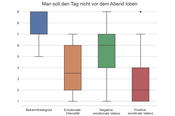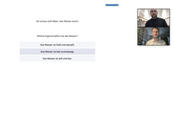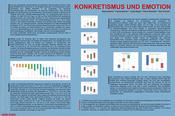Why Not Combine Learning with Research?
With the Student Research Opportunities Programx – or in Short: “StuROPx” – the Berlin University Alliance offers two formats in which students are involved in research – with their own projects
Sep 29, 2021
Students on the road on the wasteland "Nasses Dreieck" in Pankow for the X-Tutorial "Der Berliner Mauer(Rad)weg".
Image Credit: Helen Haserodt
The success of Berlin's universities in the excellence strategy of the Federal Government and the Länder is great for researchers – but what do we get out of it? Many students wondered about this. The Berlin University Alliance (BUA) has now been offering two novel concepts since the summer semester of 2021: to strengthen the connection between research and teaching: X-Tutorials and X-Student Research Groups.
X-Tutorials allow two students at a time to apply for a research project of their choice that they will implement with other students over up to two semesters. The project leaders receive tutorial positions for this purpose, and the participants receive credit points. “Students often have very unconventional approaches to topics, which is very refreshing,” says Nina Lorkowski, who coordinates StuROPx with her colleague Julia Rueß in the Cross-Cutting Theme Teaching and Learning. “The X-Tutorials are intended to create scope for tackling innovative projects, and for tutors to gain initial experience in teaching and project organization in the process.” In keeping with the spirit of the alliance, students can easily participate in projects of all four BUA partner institutions – Freie Universität Berlin, Humboldt-Universität zu Berlin, Technische Universität Berlin, and Charité – Universitätsmedizin Berlin.
Project ideas often arise from casual chit-chat – as in the case of Pia Rafalski and her co-tutor Flora Rogin. Both are pursuing historical urban studies at Technische Universität Berlin. “We were sitting in our shared apartment in the evening talking about our studies when our institute director forwarded us the mail about the X-Tutorials,” Pia Rafalski recounts. “We are both interested in dealing with architectural heritage, and after short research we realized that the Berlin Wall bicycle lane would be an exciting topic on which little research has been done so far.”
After a year of Corona-conditioned online study, it also seemed like a brilliant idea to finally work with a group “live” again. To “experience” the object of research by cycling along the Wall trajectory together while exploring specific projects for small groups.
This also convinced the reviewers – especially since the participants come from very different study programs: from urban studies, urban ecosystem sciences, geography, urban planning, cultural studies to landscape architecture. “Some are there to further their own specialist expertise. Others to see beyond,” says Pia Rafalski. In the beginning, there were two joint bicycle tours – in the north from Tegeler Fließ to Wollankstraße and in the south towards Teltow-Seehof. Everything else was discussed in online discussion groups.
“On the northern tour, the Wall bicycle lane touches the so-called “Grüne Band Berlin” (Berlin Green Belt), a strip of green where previously there were many species-rich wastelands,” Pia Rafalski points out. “One group is studying succession – the return of plant and animal life natural to the site – in wastelands that still exist. A second team is exploring the soundscapes there.” With recordings of the “soundscapes” at different times of day and different weather conditions, the junior researchers want to capture and document the special nature of the places. A third group makes a “participant observation” in Teltow-Seehof, looks at the different cultures of mobility and remembrance, and asks travelers along this route, why they use the route.
Both tutors are also actively researching in the small groups themselves. What does Pia Rafalski draw for herself personally from the tutorial? “It's a great experience to work with students from so many disciplines. You get a lot of exciting insights; you can exchange ideas about the different methods in the subjects, and the conversation always takes place at eye level.” What's more, it's easy to combine work and study. The urbanist is currently writing a term paper on the wasteland project and can imagine the Wall bicycle lane becoming her master's thesis topic.
Whoever has completed the third semester of study can become an X-tutor. To become an X-Student Research Group leader, you must be more advanced. Like Benjamin Wilck, who is doing his doctorate on the philosophy of mathematics at Humboldt-Universität zu Berlin. Together with Ivan Nenchev, assistant physician of psychiatry at Charité, he applied for a teaching research project on “Schizophrenia and Figurative Language.” Both have been good friends for years and discuss their work a lot. “Schizophrenia has interested me for a long time – from an epistemological point of view, since as a philosopher, I question the foundations of a science: Are the definitions consistent with each other – and with the examples? What background assumptions does a theory make without being explicitly stated?” says Benjamin Wilck.
People with schizophrenia usually cannot interpret emojis. They do not perceive irony, but figurative expressions at face value. If you ask them, for example, what the expression “To be a chip off the old block” means, the answer is usually the same: “Well, the chip is very close to the block”. Psychiatrists call this phenomenon concretism. Benjamin Wilck and Ivan Nenchev read all publications on the relevant tests and found that they contained logical errors and inconsistent background assumptions about understanding figurative language.
Concretism was first observed in the 1930s and has been scientifically studied since the 1950s. “Since then, the studies have become more and more complex, but they are still founded on the same basic assumptions – and these are wrong,” says Benjamin Wilck. One assumes, among other things, that healthy people intuitively recognize metaphors and irony. “Conversely, that would mean: People who can't do that are not healthy.” However, concretism is only one symptom of schizophrenia and not sufficient for the diagnosis.
Together with 15 students from medicine, psychology, linguistics, literature, and art studies, the two group leaders discussed such discrepancies and designed small new experiments, which they then tested on a group of healthy people. For their seminar, they had invited a colleague from the Medical Humanities department at the University of Cambridge. “Now we have been proposed a cooperation by Cambridge! This wouldn't have happened at all without StuROPx,” says Benjamin Wilck happily.
What does he himself gain from the project? Like Pia Rafalski, Benjamin Wilck also values the input of different disciplines. “At my institute, there are philosophy students who might think very perceptively about metaphor,” he says, “but there is no critical exchange with students and researchers in other disciplines.” The professional tension between the two seminar leaders was also interesting. “Since we know each other well, it's going very nicely. But usually, a doctor can hardly understand a philosopher's critique because medical school doesn't include logic seminars.”
What criteria does the selection committee use to choose projects? “The focus is on research. Funding is not provided for seminars on a topic, but for research projects with students. In addition, interdisciplinary and innovative approaches to a topic also play a role. And we make sure that they really are the own ideas – and not those of a professor behind them,” says Nina Lorkowski. For the leadership of both formats, there are separate training courses on “research-based learning” to provide them with the best possible qualifications.
8 X-Tutorials and 16 X-Student Research Groups were funded in the first round. Even the first time, there were many more applications than places. No wonder, because the idea behind StuROPx is as simple as it is wise: Students should not learn from research, but participate in research, not just contribute, but go through all phases of a research process themselves and be involved in the development of sub-questions. In this way, research competence is promoted at an early stage.

